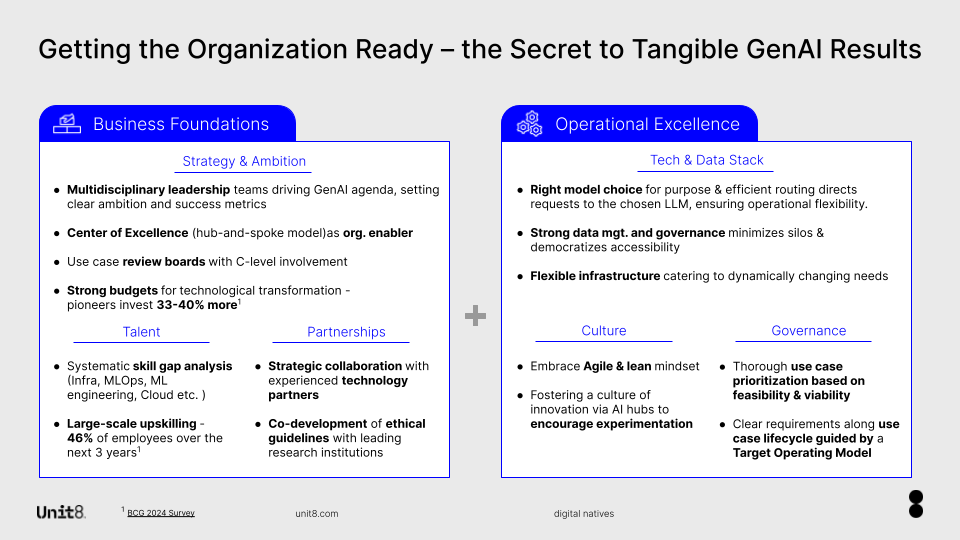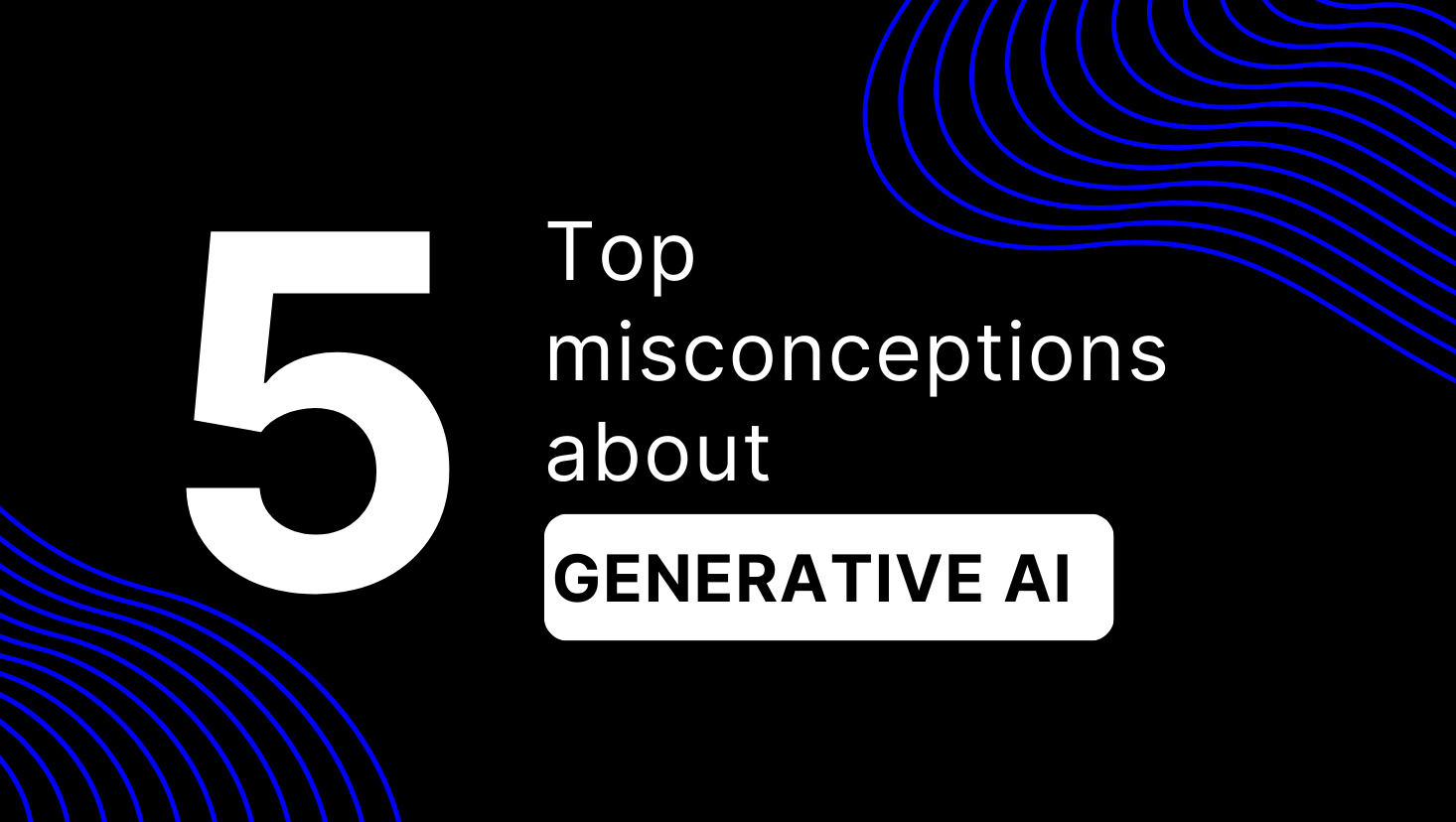
- Jun 5, 2024
- 6 minutes
-
 Dr. Áron Horváth
Dr. Áron Horváth
Organizations stand on the verge of an AI revolution, with the promise of Generative Artificial Intelligence (GenAI) to transform their traditional business models and the services they offer. The excitement surrounding the potential of GenAI is evident, but the level of organization readiness required for a sustainable GenAI transformation is oftentimes overestimated.
Firms gaining traction with GenAI initiatives share a common strategy that involves the careful selection of low-risk use cases that are aimed at establishing a constructive model for the wider integration of GenAI technology while securing the backing of diverse stakeholders. By demonstrating the effectiveness and efficiency of GenAI in controlled, manageable scenarios, organizations can build a replicable case for scaling up these technologies. This approach also allows for the gradual education and engagement of stakeholders, who may range from internal team members to external partners and customers, ensuring that they are on board with the transformative potential of GenAI.
Yet, moving past low-risk use cases towards more scalable ones is where we see most organizations struggling based on our experience supporting 20+ clients launch and scale their GenAI use-cases. At Unit8, we believe that only via a mix of initiatives around business foundations and operational excellence can firms be ready to fully reap the benefits and ROI promised by GenAI. We address these 2 dimensions and their respective pillars in the next sections.

Business Foundations
Business foundations are established around three key pillars: strategy & ambition, an adequate talent pool, and strategic partnerships. Let’s delve deeper into these key aspects.
- Strategy & Ambition
The first pillar of a successful GenAI transformation is a clear company strategy and high level of ambition. This involves the establishment of multidisciplinary leadership teams driving the GenAI agenda, setting clear ambitions, and defining success metrics. These teams are responsible for guiding the organization’s AI journey and ensuring alignment with the overall business strategy. A key component of this pillar is the establishment of a Center of Excellence (CoE), following a hub-and-spoke model. A CoE acts as a central organizational enabler (the hub) by providing the right level of guidance and support to the different business units (the spokes). To ensure that the ambition is in alignment with the company’s strategy objectives, it is crucial that C-level executives are involved in the decision-making process, and commit dedicated budgets for such technological transformation. Pioneers in this field typically invest 33-40%[1] more than their industry counterparts, demonstrating their dedication to leveraging AI for business growth. - Talent Pool
Realization of the ambition-fuelled strategy lies on a skilled talent pool. Therefore, a systematic skill gap analysis is crucial to identify areas of improvement in various domains such as infrastructure, MLOps, ML engineering, and Cloud. This analysis helps in understanding the current capabilities of the workforce and the skills needed to drive the GenAI initiative. Once the skill gaps are identified, large-scale upskilling becomes a priority, since the shortage of this special workforce can lead to bottlenecks in project development and deployment, as well as increased reliance on a limited pool of experts. It is estimated that 46% of employees will need to be upskilled over the next three years to meet the demands of AI-driven business operations[1]. This not only involves training in technical skills but also fostering a culture of continuous learning and innovation as well as attracting new talent with the requisite expertise in GenAI. - AI Partnerships
It is indisputable that GenAI is rapidly taking the world by storm. As the pace of GenAI transformation accelerates, it is becoming clear that staying ahead without strategic partnerships is nearly impossible. By collaborating with experienced technology partners, organizations can accelerate their AI transformation by accessing cutting-edge AI technologies and know-how. These partnerships can also facilitate knowledge sharing and co-innovation, enabling the organization to stay ahead of the curve in the rapidly evolving AI landscape. Additional collaborations with leading research institutions and participation in industry consortia can lead to the co-development of ethical guidelines for AI use, ensuring that GenAI initiatives are not only successful, but also ethical and responsible. Moreover, such alliances allow organizations to tap into emerging talent pools and thus strengthen their strategic approach for talent management.
Operational Excellence
Beyond the pillars of business foundation, operational excellence fuels GenAI initiatives through the careful selection of technology and data stacks, by fostering a culture of continuous improvement and AI literacy, and implementing effective governance practices. In the next section, we unravel these fundamental elements.
- Tech & Data Stack
With the current accelerating pace of the GenAI technological evolution, it is fundamental to choose the right tech and data stack for a successful GenAI journey within an organization. The decision process for the adequate Large Language Models (LLMs) must consider the intended use and thus consequently the expected performance, accessibility and customization possibilities (i.e., open-source vs proprietary models) along the legal and compliance requirements. But to unlock the GenAI capabilities to its full extent, it is required to establish strong data management and governance by minimizing data silos and democratizing accessibility. All this needs to build upon a flexible infrastructure that can cater to dynamically changing needs, which in turn ensures that the organization can adapt and evolve its GenAI capabilities as needed, promoting long-term success.
- Culture
In the rush to recruit employees with specialized GenAI expertise to address the talent gap, the broader goal of fostering AI literacy across the organization is often overshadowed. This oversight can create a disconnect, leaving employees without the necessary foundational knowledge to fully understand AI’s transformative impact on their roles and the broader organizational context. Without a fundamental understanding of AI, employees may find it challenging to effectively discuss AI initiatives, make strategic decisions about AI adoption and management, or fully appreciate the ethical and bias-related concerns that AI can present. As AI becomes increasingly embedded in business operations, the ability to proactively manage these issues is crucial for maintaining trust and integrity. Therefore, fostering a culture infused with AI literacy throughout the organization is not just important but essential, ensuring that AI is leveraged effectively and responsibly. It empowers all employees to confidently navigate AI-driven changes, fostering an organizational culture that is prepared to harness and benefit from the full potential of AI technologies. - GenAI Governance
From a governance perspective, the integration of GenAI innovation within an organization presents a multifactorial risk landscape that must be navigated with strategic oversight. Effective governance requires the establishment of clear policies and a robust framework to manage the ethical, operational, and compliance risks associated with GenAI. This includes defining, implementing and monitoring strong requirements along the use case lifecycle for data privacy, ensuring the transparency of AI decision-making processes, and maintaining rigorous compliance with evolving regulatory requirements. Simultaneously, by prioritizing use cases on the basis of feasibility and viability, resources are efficiently distributed and projects with the highest potential impact receive precedence. This inherently leads to better use of resources and higher returns on investment. Lastly, clear requirements along the use case lifecycle, guided by a Target Operating Model, ensure that everyone involved understands the project’s objectives and deliverables.
Summary
The prospects of GenAI are undeniable, with its promise of innovation and competitive edge fueling a sense of urgency among organizations to adapt swiftly. Yet, in the race to stay ahead, it’s crucial not to overlook the key aspects of organizational readiness. Business foundations coupled with operational excellence standing on six distinct pillars are essential to fully realize GenAI’s potential. As a closing remark, this executive brief serves as a guideline for companies to prepare their organizations for the complexities of GenAI adoption, creating an environment where GenAI innovation can succeed.
References
[1] BCG 2024 Survey


